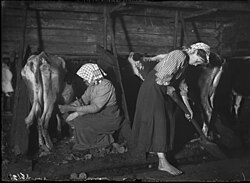
A milkmaid, milk maid, milkwoman, dairymaid, or dairywoman is a girl or woman who works with milk or cows. [1] She milks cows and may prepare dairy products such as cream, butter, and cheese. The term milkmaid is not the female equivalent of milkman in the sense of one who delivers milk to the consumer;[ citation needed ] it is the female equivalent of milkman in the sense of cowman or dairyman. [2]
Contents
In 1600s-1800s, English milkmaids sold milk wearing a yoke supporting two milk pails and vending vessels, and also decorated themselves for the London May Day procession. [3] [4]


